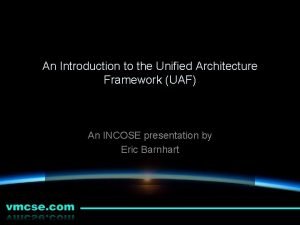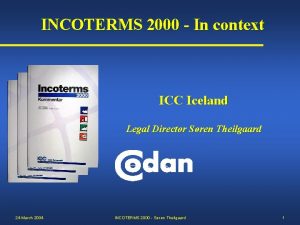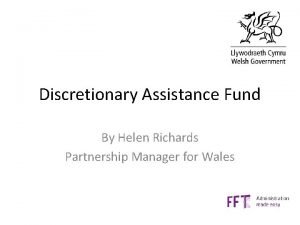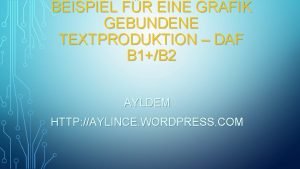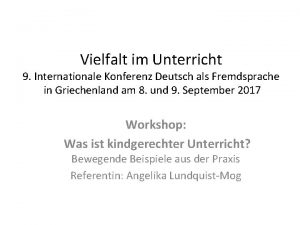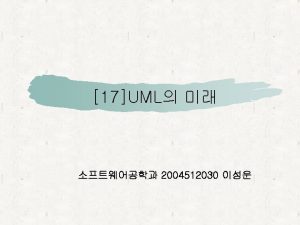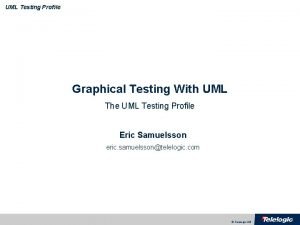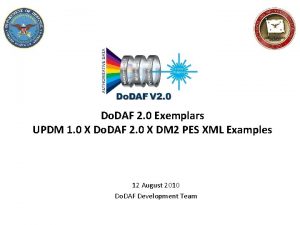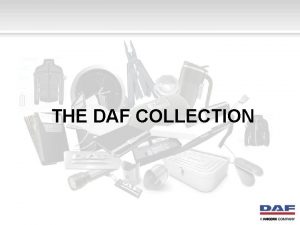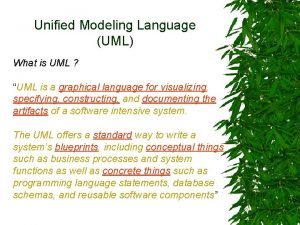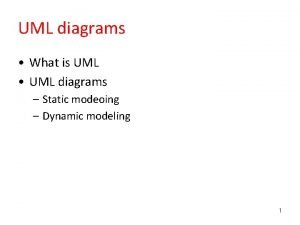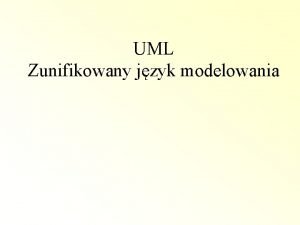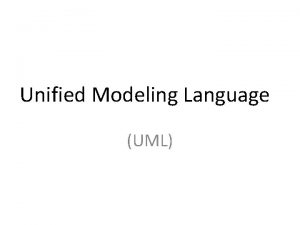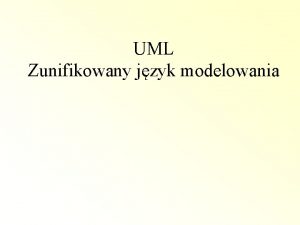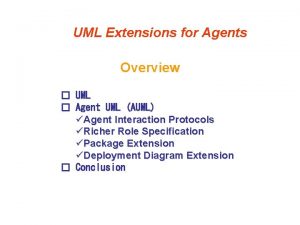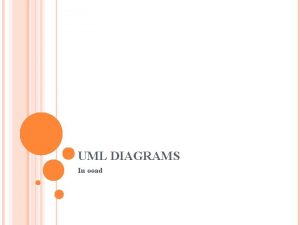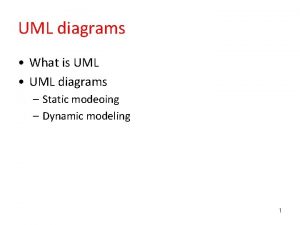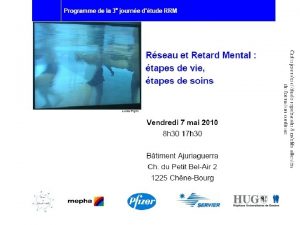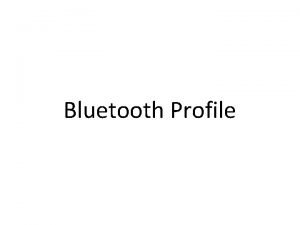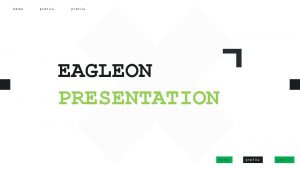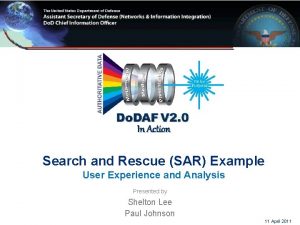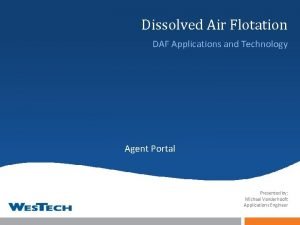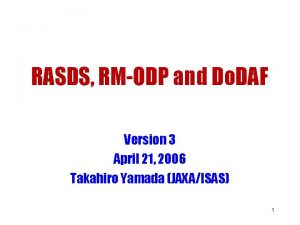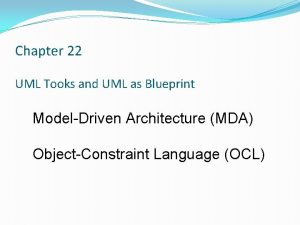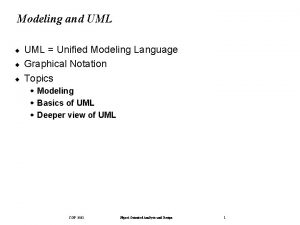UPDM UML profile for Do DAF and MODAF







































- Slides: 39

UPDM – UML profile for Do. DAF and MODAF Briefing to the Do. DAF WG May 16, 2007

UPDM – UML Profile for Do. DAF and MODAF Introduction to the UPDM specification submission § Background § Approach § Highlights § Deep dive if requested 2 May 16, 2007 – Do. DAF Workgroup and UPDM Team Briefing

UPDM – UML Profile for Do. DAF and MODAF Background – The Object Management Group (OMG) § OMG is an international industry consortium that produces industry standards using a rigorous technology adoption process – UML, Sys. ML, MDA™, etc. § UPDM Requirements derived from Do. DAF and MODAF requirements § UPDM development included broad industry participation from tool vendors and end users, as well as Do. D/MOD inputs to requirements § UPDM supports current Do. DAF/MODAF requirements and can evolve to meet future needs – Can produce standard Do. DAF products – Leverages cross industry standards based approaches (e. g. , MDA™ , UML, Sys. ML) to enhance tool and architecture data interoperability – MDA™ foundation enables UPDM to evolve with Do. DAF v 2 and beyond as needs evolve (i. e. SOA) – UPDM is methodology agnostic (structured, OO, . . ) 3 May 16, 2007 – Do. DAF Workgroup and UPDM Team Briefing

UPDM – UML Profile for Do. DAF and MODAF Background: UPDM Timeline – Teams and Submissions Do. DAF v 1. 0 (2004) Do. DAF v 1. 5 Draft Inputs MODAF v 1. 0 OMG Kickoff RFP issued Three Initial Submissions UST and Telelogic Merge Feb 2005 4 Sept 2005 June 2006 May 16, 2007 – Do. DAF Workgroup and UPDM Team Briefing Two Revised Submissions Unified Submission OMG Adopts UPDM Team 1 & Alpha Merge Nov Dec 2006 March 2007 June 2007

UPDM – UML Profile for Do. DAF and MODAF Background – Briefings and Feedback 2007 Event 2006 Event Jun OMG C 4 I and Board Dec Jun MODAF – TBD - Brussels Mr. Brian Wilczynski Key Note speaker at OMG’s UPDM info Day Jun NATO – TBD - Brussels Dec May DISA - TBD Mr. Tillotson key note speaker at OMG’s Architecture info day (C 4 I, UPDM, and Software Assurance) May Impact Presentation - commercial Nov AFITC presentation May Briefing to Do. DAF WG Oct Briefing to SAF/XC on UPDM May Briefing to NCOIC Technical Oct Briefing to DODAF WG on UPDM May JFCOM Presentation Sep NCOIC Presentation Apr Do. D Architects Conference Sep Joint NII and OSJTF briefing to Acquisition M&S WG Apr INCOSE Review / Study – Patterns Jul Apr Briefing to SAF/XC on UPDM Army ARCIC workshop on DODAF support for OO/UML Mar OMG C 4 I Presentation / Review Feb Coordination meeting with MOD and Do. D Jan Briefing to INCOSE International Workshop Sept 05 Briefing on UPDM to OSJTF workshop May 05 Briefing to DODAF WG Jan Briefing to DODAF WG Vol II review session on UPDM May 05 Workshop at Mitre with OSD NII, OSJTF, and Army PEO GCS 5 May 16, 2007 – Do. DAF Workgroup and UPDM Team Briefing

UPDM – UML Profile for Do. DAF and MODAF Background: Summary of Do. DAF B C System Functionality Description (SV-4) Systems Functionality Sequence and Timing Description (SV-10 a/b/c) Y X Systems Interface Description (SV-1) Activity to System Function (SV-5) Physical Schema SV-11 tem s Systems Evolution Description (SV-8) Standards Technology Forecast (TV-2) l ica Systems Communications Description (SV-2) Technical Architecture Profile (TV-1) chn Te System - System Matrix (SV-3) XY Z X Y Sys NODES TIME A T 1 T 2 T 3 Operational Systems Data Exchange Matrix (SV-6) Systems Performance Parameters Matrix (SV-7) Operational Concept Description (OV-1) Systems Technology Forecast (SV-9) Operational Activity Model (OV-5) • . . . Organizational Relationships Chart (OV-4) 6 Node Connectivity Description (OV-2) • - Logical Data Model (OV-7) Information Exchange Matrix (OV-3) May 16, 2007 – Do. DAF Workgroup and UPDM Team Briefing NODES TIME A T 1 T 2 T 3 B C Operational Activity Sequence and Timing Description (OV-6 a/b/c)

UPDM – UML Profile for Do. DAF and MODAF Background – Summary of MODAF Inputs: Outputs: Doctrine & SAGs Cap Audit Legacy Systems 7 Inform Standards Inform Prog Plans Inform Do. DAF Views Inform Strategic View Operational View Optimise Capability Phasing Provides Operational Concepts Technical View Defines System Components & Key Interface Points Structures the Mandated Standards Acquisition View Provides the Route map System View May 16, 2007 – Do. DAF Workgroup and UPDM Team Briefing Improved Policy Coherent Effects System of Systems Standards and Principles NEC Roadmap Context

UPDM – UML Profile for Do. DAF and MODAF Approach – Submission Documents UPDM Joint Submission Compliance Level 1 c 4 i/07 -02 -01 Class Library (xmi) c 4 i/07 -03 -07 Domain Meta-model (xmi) c 4 i/07 -02 c 4 i/07 -03 -04 Profile (xmi) c 4 i/07 -03 -05 c 4 i/07 -03 -06 UPDM Class Library, Domain Meta-model, Profile (HTML) c 4 i/07 -03 -09 c 4 i/07 -03 -09 Errata 8 Complianc e Level 0 c 4 i/07 -03 -08 May 16, 2007 – Do. DAF Workgroup and UPDM Team Briefing

UPDM – UML Profile for Do. DAF and MODAF Approach - Addressing Request for Standard Submission Requirements § Mandatory (Submission Annex A) – – – [6. 5. 1] Meta Model (abstract syntax and constraints) [6. 5. 2] Profile [6. 5. 3] Notation (concrete syntax) [6. 5. 4] Do. DAF 1. 0 and MODAF 1. 0 artifacts [6. 5. 5] Additional Views and Viewpoints – [6. 5. 6] Element Taxonomy Reference – [6. 5. 7] Data Interchange (Sections 4 - 6) (Sections 4 – 6 for semantics) (Sections 4 & 6 for custom Views and Section 7 on Extensibility) (Sections 4 & 6 (Supplementary Files) § Optional – – 9 [6. 6. 1] Domain Meta Model Data Interchange Mappings and Transformations Extensibility to Other Architecture Frameworks Representation of Architectural Patterns May 16, 2007 – Do. DAF Workgroup and UPDM Team Briefing (Annex C) (Supported by XMI) (Section 7, SOA Extensions) (SOA, UML)

UPDM – UML Profile for Do. DAF and MODAF Approach § Unified submission – Combines the perspectives of the initial submission teams – Exploitation of both UML and Sys. ML – Compliant specification that addresses the needs of Do. DAF and MODAF – Supports both architect and System Engineers perspectives § Domain Metamodel § XMI exports § Working proof of concept – Demonstrated at OMG conference § Do. D relevant example included § HTML export of all models 10 May 16, 2007 – Do. DAF Workgroup and UPDM Team Briefing

UPDM – UML Profile for Do. DAF and MODAF Approach – Principles for Designing UPDM Topic Direction Comment Frameworks Do. DAF, MODAF, FEA Acceptance Open Standard Direction NCO, SOA, System Engineering Schedule On Schedule Professions Plus more Must be widely supported Open Standard Tools can import/export legacy User feedback is best Architect, Engineer, Developer, more Professions interlock and sharing Modeling UML & Sys. ML Model interoperability and reuse Accuracy Proof of Concept Rigorous software engineering method, MDA™ Specification Model Transforms Generate specifications from models Governance Agile, team based Consensus based approach Semantics Interchange Profile Architecture Industries 11 Domain Model drives Profile XMI MDA™ Model Oriented Widely applicable Do. DAF domain model ability to reason Import/export to repositories and tools Transforms between standards Models with Multiple Views, ad hoc model queries Defense, Commercial, Academic May 16, 2007 – Do. DAF Workgroup and UPDM Team Briefing

UPDM – UML Profile for Do. DAF and MODAF Approach: Role of UPDM Domain Meta. Model § Do. DAF and MODAF concepts were used as inputs for the UPDM Domain Meta. Model § The Domain Meta. Model established the context for the UML profile Do. DAF MODAF Domain Meta. Model exa mp l e UML Profile 12 May 16, 2007 – Do. DAF Workgroup and UPDM Team Briefing

UPDM – UML Profile for Do. DAF and MODAF Approach – Model-Based § As the complexity of a problem increases, the use of modeling becomes necessary to describe both the problem space as well as the solution. § Providing additional Do. DAF/MODAF semantics to the modeling experience allows users to create models that exhibit those semantics. § These semantics provide consistency and allow generation of the typical Do. DAF/MODAF products as views of the model contents. § The model becomes the repository from which various views can be extracted. 13 May 16, 2007 – Do. DAF Workgroup and UPDM Team Briefing

UPDM – UML Profile for Do. DAF and MODAF Approach: Profile Conformance § The profile has two conformance levels – Level 0 – all UML may be used – Level 1 – defines Sys. ML-specific extensions to Level-0 § We expect models created conformant with Level 0 and Level 1 to be interoperable since – Standard UPDM profile being used – XMI 2. 1 specified as the basis for interchange – UML 2. 1. 1 specified as the base language for Level 0 – Limited to the UML 4 Sys. ML subset – Level 1 extensions based on standard Sys. ML profile of UML Level 0 UML 4 SYSML Level 1 SYSML 14 May 16, 2007 – Do. DAF Workgroup and UPDM Team Briefing

UPDM – UML Profile for Do. DAF and MODAF Approach: The OV-1 for UPDM Domain Meta Model Graphics View Gen. BPMN View Level 1 Sys. ML UML 4 SYSML IDEF Transform Project Mngt UPDM Profile and Library Other Profiles Spreadsheet URI + model data External Links UPDM Profile Meta Model SOA Profile Models IDEF Models BPMN Apply Icons, Attributes Level 0 15 May 16, 2007 – Do. DAF Workgroup and UPDM Team Briefing Import & Export UML XMI

UPDM – UML Profile for Do. DAF and MODAF Approach: Proof of Concept § Technology Proof of Concept: § Approach was to build and test iteratively – Most of the time this worked – Sometimes we were surprised – Some corner cases of UML were not addressed in the Rational modeling tools – In all cases, we were able to identify the shortcomings and working with engineering, develop workarounds and schedule product fixes § Domain Proof of Concept: – Engaged with team members steeped in Do. DAF experience – Applied UPDM profile and modeled real-life example – Finding an unclassified example was difficult! 16 May 16, 2007 – Do. DAF Workgroup and UPDM Team Briefing

UPDM – UML Profile for Do. DAF and MODAF Approach - Features Feature Comment Capability and Effects Unification of Strategic, Operational and Service elements Operational to Systems Mappings Systems. Node and Operational. Activity. Realization maps to System Functions Service Oriented Architecture Model operational nodes, systems and actors as Services External Systems Links to taxonomies, requirements, repositories, view generators Traceability Context free activities and decomposition of Activities and System Functions Community Link Engineers and Architects Reuse Open Standard Model, import / export, transforms, queries, reporting Validation Open Standard Model, queries for validation FEA Alignment Top down modeling from Enterprise, Strategic. Mission, Goals and Vision Roles Competency Roles, competency, resources and operational nodes Activity Contexts Allocation of activities and system functions to operational nodes and system Reporting Do. DAF and MODAF views and ad hoc model queries, export Patterns Reusable Asset Specification for pattern repository Extensibility Viewpoints/stakeholders External references 17 May 16, 2007 – Do. DAF Workgroup and UPDM Team Briefing

UPDM – UML Profile for Do. DAF and MODAF Errata Summary Minor changes to the specification resulting from validation and testing. § OCL stereotype specialization validation § Remove “UPDM” from stereotype names § Fix Architecture View OCL § Several typos § One diagram missing “ownership” line § Other OCL bugs § Added note on patterns and other architectures 18 May 16, 2007 – Do. DAF Workgroup and UPDM Team Briefing

UPDM – UML Profile for Do. DAF and MODAF Highlights of the solution – Node and Operational Capability Profile specification metamodel 19 May 16, 2007 – Do. DAF Workgroup and UPDM Team Briefing

UPDM – UML Profile for Do. DAF and MODAF Highlights of the solution – Comprehensive Traceability Usage example with UML “stereotype” notation 20 May 16, 2007 – Do. DAF Workgroup and UPDM Team Briefing

UPDM – UML Profile for Do. DAF and MODAF Service Component <<Operational. Service. Provider>> 21 May 16, 2007 – Do. DAF Workgroup and UPDM Team Briefing

UPDM – UML Profile for Do. DAF and MODAF Do. DAF Artifact Approach: Deriving the View from the Model § The specification provides support for information needed to deliver all Do. DAF products but does not constrain users to use UML or Sys. ML. If the architecture can produce the needed elements, then it is “UPDM compliant” for the view. § The specification provides mechanisms to support export of information to other tools, such as a project management tools. § The specification also supports clear mechanisms for extensions of new views as needed on projects. For example, security, logistics, or service delivery might require additional diagrams. § Annex B of the specification provides a non-normative overview of strategies for delivering products based on the profile elements. The next slide shows portions of the tables included for all artifacts. 22 May 16, 2007 – Do. DAF Workgroup and UPDM Team Briefing

UPDM – UML Profile for Do. DAF and MODAF The Artifact Guidance in the Specification: OV 5 Example Each Artifact Has a List of Elements UPDM Element Significance to the View Activity. Realization Maps an Operational. Activity to the collection of Systems, people, and Resources used to implement that activity. Effect An Effect is an action that causes a change in the state of some other element, such as an enemy or physical control over space. Some approaches to activity planning stress achieving certain conditions, such as air supremacy or control of strategic points. Operational. Tasks and collaborating Operational. Nodes will bring about the effect. Information. Element A formalized representation of information used in an operational process. This is the type of information used on the exchange. On activity diagrams, the Information. Element can appear on the input or output pins or as an activity parameter. Information. Exchange Materiel 23 While the Information. Exchange is usually associated with the OV-3, on the OV-5 a user can show information exchanges between Nodes, where the nodes appear as Activity Partitions on the Activity Diagram. The physical resources used to accomplish a particular mission. In the OV-5, materiel can include physical resources critical to mission success. Each Artifact Relates to Other Views View Relationship Details OV-2 The activities annotating an operational Node in an OV-2 map to the Operational. Activities described in an OV -5. Similarly, OV-5 should document the operational Nodes that participate in each Operational. Activity. OV-3 An Information. Exchange in OV-3 should map to one or more information flows (an external Input, an external output, or an output from one Operational. Activity mapped to an input to another) in OV 5, if OV-5 decomposes to a level that permits such a mapping. Above that level of decomposition, a single information flow in an OV -5 may map to more than one Information. Exchange (or none, if the information flow does not cross Node boundaries). Note that a physical flow is NOT represented as an information flow. A review of physical exchanges in a model requires a custom view. OV-6 A rule may define conditions that constrain the execution an Operational. Activity in a specific way, or constrain the organization or human role authorized to execute an Operational. Activity. Effects in the OV-6 b map to Operational. Activities in OV-5. SV-5 Operational Activities in SV-5 match Operational. Activities in OV-5. This is detailed for all artifacts and includes examples from prototypes. May 16, 2007 – Do. DAF Workgroup and UPDM Team Briefing

UPDM – UML Profile for Do. DAF and MODAF Highlights of the solution – Operational Activity and System Function Link By placing the System. Function inside the Operational. Activity. Realization collaboration the model has all the information to generate the SV-5. 24 May 16, 2007 – Do. DAF Workgroup and UPDM Team Briefing

UPDM – UML Profile for Do. DAF and MODAF Highlights of the solution - V-5: An Illustration of Exported Information SV-5, exported from model to external tool (Excel) Dynamic diagrams with system element stereotyped placed in an Operational. Activity. Realization provide the information needed for the SV-5 See the UPDM Specification for a more detailed review of examples and artifacts. UPDM provides definitions of needed elements for automation, but it does not specify the implementation of the needed model queries or transformations. 25 May 16, 2007 – Do. DAF Workgroup and UPDM Team Briefing

UPDM – UML Profile for Do. DAF and MODAF Highlights of the solution - Sys. ML Internal Block Diagram Compliance Level 1…Using Sys. ML Requirements, Problems and Rationale can be attached to any Model Element to Trace Requirements and Capture Issues and Decisions 27 May 16, 2007 – Do. DAF Workgroup and UPDM Team Briefing

UPDM – UML Profile for Do. DAF and MODAF Highlights of the solution - OV-1 Representation OV-1 Captures the Operational Context graphically and as Role and Use Case models representing Mission Context, Scenarios and enabling Capabilities 28 May 16, 2007 – Do. DAF Workgroup and UPDM Team Briefing

UPDM – UML Profile for Do. DAF and MODAF Highlights of the solution - OV-5 Representation OV-5 Activity Diagram captures the behavior defined by OV-1 Use Cases via Operational Activities subsequently allocated to Operational Nodes 29 May 16, 2007 – Do. DAF Workgroup and UPDM Team Briefing

UPDM – UML Profile for Do. DAF and MODAF Highlights of the solution - OV-2 Representation OV-2 Operational Nodes and Needlines as aggregations of allocated Operational Activities and Information Flows respectively 30 May 16, 2007 – Do. DAF Workgroup and UPDM Team Briefing

UPDM – UML Profile for Do. DAF and MODAF Highlights of the solution - OV-3 Matrix Generation OV-3 Information Exchange Matrix auto generated based on Operational Activity Information Flows 31 May 16, 2007 – Do. DAF Workgroup and UPDM Team Briefing

UPDM – UML Profile for Do. DAF and MODAF Highlights of the solution - OV-4 Representation OV-4 Organizations and Roles allocated to each Organization are modeled by UML Composite Structure and Sys. ML and Block Definition Diagrams 32 May 16, 2007 – Do. DAF Workgroup and UPDM Team Briefing

UPDM – UML Profile for Do. DAF and MODAF Highlights of the solution - OV-6 a Representation OV-6 a Captures the Operational Rules allocated to Operational model elements including Nodes, Activities, Flows, Information Elements and States 33 May 16, 2007 – Do. DAF Workgroup and UPDM Team Briefing

UPDM – UML Profile for Do. DAF and MODAF Highlights of the solution - OV-6 b Representation OV-6 b State Trace Diagram captures the Operational States and Transitions within Operational Nodes 34 May 16, 2007 – Do. DAF Workgroup and UPDM Team Briefing

UPDM – UML Profile for Do. DAF and MODAF Highlights of the solution - OV-6 c Representation OV-6 c Event Trace diagram captures the event flow (messages) between instances of Operational Nodes…synchronized with Operational Activities allocated to Nodes 35 May 16, 2007 – Do. DAF Workgroup and UPDM Team Briefing

UPDM – UML Profile for Do. DAF and MODAF Highlights of the solution - OV-7 Logical Information Model OV-7 Defines Information Model for all Operational Information Flow elements identified within the integrated model and viewed via OV-3 and OV-5 36 May 16, 2007 – Do. DAF Workgroup and UPDM Team Briefing

UPDM – UML Profile for Do. DAF and MODAF Highlights of the solution - SV-1 Representation SV-1 Provides the view of the Systems, their connections and data flows, and allocations to Mission Scenarios and Operational Activities 37 May 16, 2007 – Do. DAF Workgroup and UPDM Team Briefing

UPDM – UML Profile for Do. DAF and MODAF Background: Broad Industry, User and Vendor Support Unified Submission Supporting Members § Adaptive § Lockheed Martin Corporation § ARTi. SAN Software Tools, Ltd. § MEGA International § ASMG § No. Magic § BAE Systems § Northrop Grumman § BCMS Consulting § Pathfinder Solutions § CSCI § Raytheon Company § Embedded. Plus Engineering § SAIC § Euro. Step Group AB § Sparx Systems Pty Ltd § General Dynamics § Telelogic AB § IBM § THALES Group 38 May 16, 2007 – Do. DAF Workgroup and UPDM Team Briefing

UPDM – UML Profile for Do. DAF and MODAF Conclusion - The Stage is set § Conformant specification that addresses the needs Do. DAF and MODAF – Standards based approach will enhance tool and architecture data interoperability – MDA™ foundation enables UPDM evolution to support Do. DAF v 2 and beyond as needs evolve (e. g. , SOA) § Integrates Architecture and Engineering – Exploitation of both UML and Sys. ML § Unified submission – Supported by broad industry consortium of tool vendors and end users § Working proof of concept – Demonstrated at OMG workshop in March Ready for adoption by OMG at meeting in June 39 May 16, 2007 – Do. DAF Workgroup and UPDM Team Briefing

Questions? May 16, 2007
 Tom coolidge
Tom coolidge Unified architecture framework example
Unified architecture framework example Incoterms daf definicion
Incoterms daf definicion Individual assistance payment
Individual assistance payment Contoh daf
Contoh daf Grafikbeschreibung beispiel
Grafikbeschreibung beispiel Rückwärtsplanung im daf unterricht
Rückwärtsplanung im daf unterricht Daf yomi advancement forum
Daf yomi advancement forum Uml 1..*
Uml 1..* Uml testing profile
Uml testing profile Formuö
Formuö Novell typiska drag
Novell typiska drag Tack för att ni lyssnade bild
Tack för att ni lyssnade bild Ekologiskt fotavtryck
Ekologiskt fotavtryck Shingelfrisyren
Shingelfrisyren En lathund för arbete med kontinuitetshantering
En lathund för arbete med kontinuitetshantering Adressändring ideell förening
Adressändring ideell förening Personlig tidbok för yrkesförare
Personlig tidbok för yrkesförare Anatomi organ reproduksi
Anatomi organ reproduksi Densitet vatten
Densitet vatten Datorkunskap för nybörjare
Datorkunskap för nybörjare Boverket ka
Boverket ka Hur skriver man en debattartikel
Hur skriver man en debattartikel Delegerande ledarstil
Delegerande ledarstil Nyckelkompetenser för livslångt lärande
Nyckelkompetenser för livslångt lärande Påbyggnader för flakfordon
Påbyggnader för flakfordon Lufttryck formel
Lufttryck formel Publik sektor
Publik sektor Jag har gått inunder stjärnor text
Jag har gått inunder stjärnor text Presentera för publik crossboss
Presentera för publik crossboss Teckenspråk minoritetsspråk argument
Teckenspråk minoritetsspråk argument Bat mitza
Bat mitza Klassificeringsstruktur för kommunala verksamheter
Klassificeringsstruktur för kommunala verksamheter Fimbrietratt
Fimbrietratt Claes martinsson
Claes martinsson Cks
Cks Byggprocessen steg för steg
Byggprocessen steg för steg Bra mat för unga idrottare
Bra mat för unga idrottare Verktyg för automatisering av utbetalningar
Verktyg för automatisering av utbetalningar Rutin för avvikelsehantering
Rutin för avvikelsehantering

